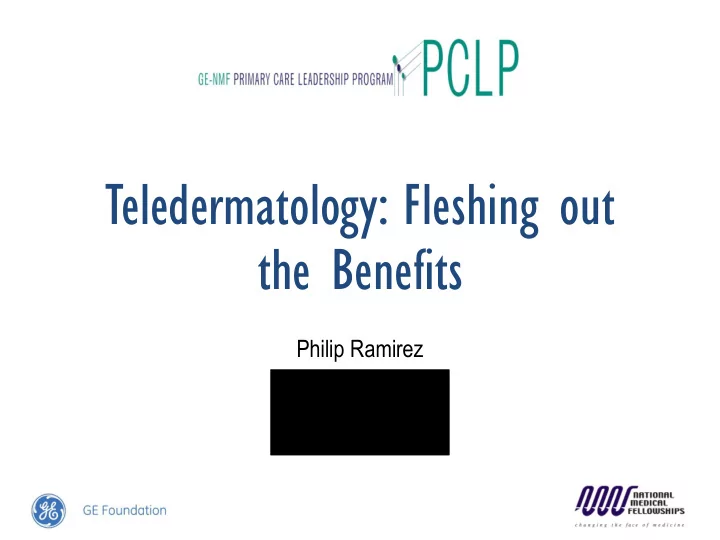

Teledermatology: Fleshing out the Benefits Philip Ramirez CentroMed San Antonio, Tx
Introduction • FQHCs are some of the most efficient methods of health care, able to bring healthcare to Medically Underserved Areas (MUA). • Access to specialty care is still a problem for most MUAs • Telehealth has the potential to address this problem with technology currently present in Community Health Centers (CHCs).
Background • Telehealth is nothing new • Dutch physician had electrocardiographs carried to him by horseback – 1905 • 1920 radiologic consults completed between ships and islands to doctors on the mainland. • US begin transmitting radiographs in 1950’s
Background (Cont’d) • Three forms of Telehealth • 1. Store-and-Forward Telehealth (SFT): objective data is digitized, stored on a server, and sent the to a specialist for assessment on their own timeline. • 2. Live-Interactive (LI): consults via web-based communications. • 3. Hybrid: SFT and LI may be combined • SFT teledermatology was used for this study due to its asynchronous nature
Methodology • Next Gen Electronic Health Records were used to identify encounters resulting in an ICD-9 dermatologic code from Jan 1, 2014 – Jun 30, 2014. • CentroMed administrative personnel provided average cost to CentroMed per visit and number of dermatology referrals for the given timeframe. They also provided average administrative time for referrals. • Research papers were used to identify costs of dermatology visits and teledermatology consults.
Results • The dermatologic load for CentroMed was almost 4 x’s less than the load determined by the American Dermatologic Association. • Regardless of this fact the amount of potential money CentroMed could save per year is ~ $70,000.00. • Administrative time for CentroMed would equate to ~80 hrs of extra time per year. • Time spent by dermatologists on patient care if all patients with a referral and those requiring a second visit for a dermatologic issue used SFT a a time savings of ~160 hrs per year.
Results (Cont’d) Visits with Dermatology ICD-9 codes compared to all other visits Dermatology patients Dermatology 40.00% 8% 35.00% 30.00% 25.00% 20.00% 15.00% 10.00% Dermatology patients 5.00% 0.00% Non- ADA load for Next Gen Dermatology Primary Care elucidated 92% Centers Load CentroMed Load
Results (Cont’d) Monetary Costs Number Cost Cost if teledermatology used ($72.00/visit, *$93.09/clinical dermatology ($38.00/patient [7]) visit) Patient's with repeat visits resulting in ICD-9 1,007 N/A $38,266.00 coding Repeat visits resulting in ICD-9 coding 1495 $107,640.00 One f/u visit for continuity of care = $0.00 Repeat visits > 1 resulting in ICD-9 coding 488 $35,136.00 Third visit avoided -$35,136.00 Referrals 695 *$64,697.55 ($26,410.00 - $64,697.00) = -$38,287.00 Total Financial Cost -$35,157.00
Results (Cont’d) Temporal Cost Number Time dermatologist spends Time dermatologist spends Administrative time spent Administrative Time spent on clinic visit (24.4 on SFT consult (7.2 for SFT operations (20 min on traditional dermatology min/patient [7]) min/patient [7]) referral (80% of referrals per patient and referral [7]) require ~ 52.5 min, 20% require 17.5 min) Patients 1007 N/A 7,250.4 min N/A 20,140 Referrals 695 16,958 min (5,004 min 31,620 min (13,900 min – 16,958 min) = - 31,620 min) = -11,954 min -17,720 min Time spent by -4,703.6 min Administrative Time Spent 2,420 min Dermatologist if utilizing if using SFT for SFT dermatology
Discussion • Findings suggest teledermatology would greatly benefit CentroMed by benefiting their constituents. • The amount of time necessary for operations would be miniscule compared to the money saved and benefits to the patients. • Cautious optimism should be drawn from this study because it is a simplistic approach to a complicated matter. • CentroMed may benefit from future projects exploring telehealth so they can remain a leader in innovations in the rapidly evolving healthcare climate.
Recommendations • Design a study more relevant to the patient needs (i.e. telepsychology) for future PCLP scholars to assess. • Use University resources and philanthropic entities to trial telehealth practices. • Utilize models set-up in California to construct these models for study. • Use California laws to lobby government officials for changes to payment schemes.
Conclusion • Teledermatology shows a potential future for expanded telehealth practices in the Community Health Care setting. • Future research projects might benefit CentroMed as the evolution of healthcare allows for telehealth reimbursements in order to remain a leader in healthcare innovation.
Acknowledgements • Raymond Wei, MS, FACHE, Vice-President of Business Development & Ancillary Services • Robert Ferrer, MD, MPH • Robert Reyna, MD • Osvaldo Villarreal, MD • Jackie Medrano-Lewis, RN • Norma Parra, MD, CMO
Recommend
More recommend